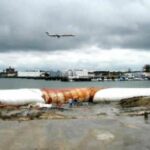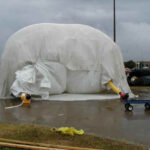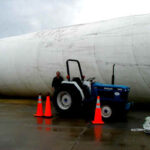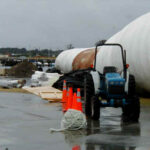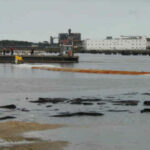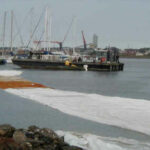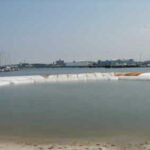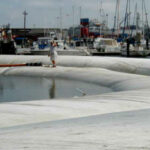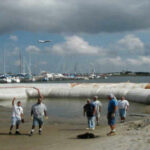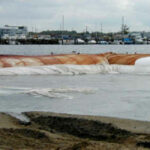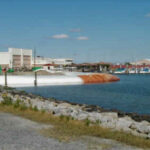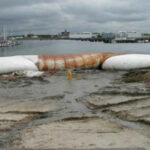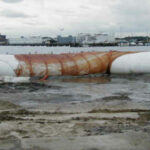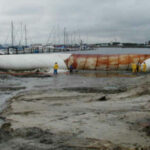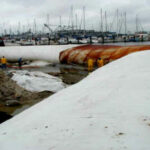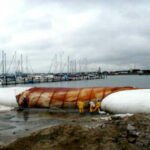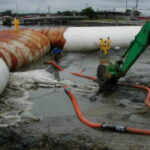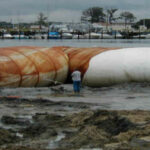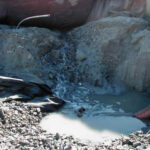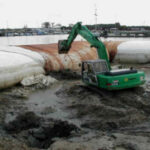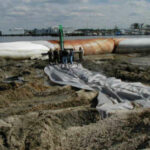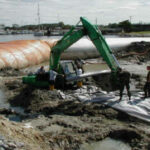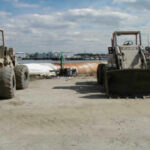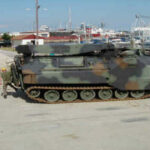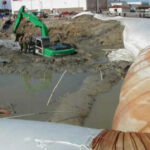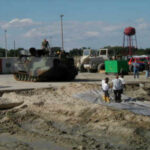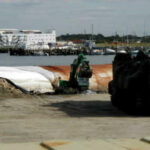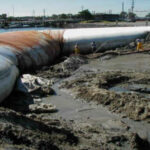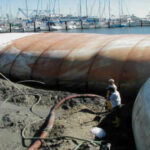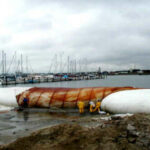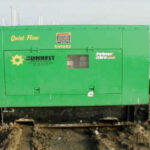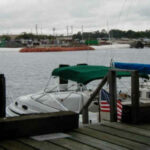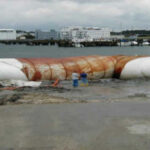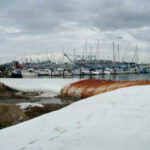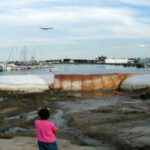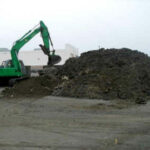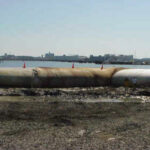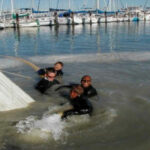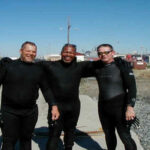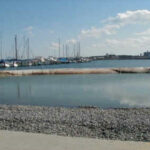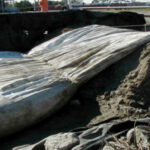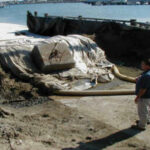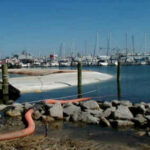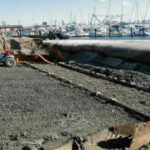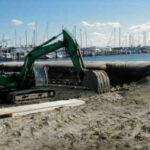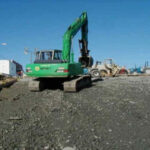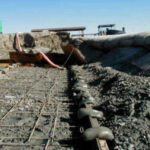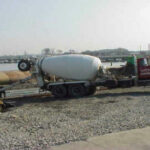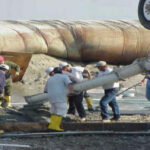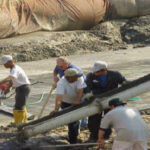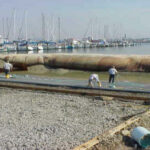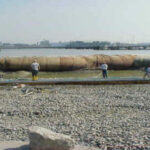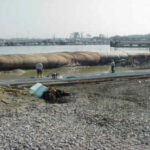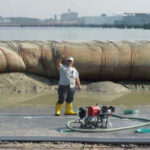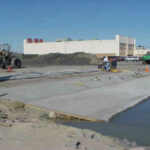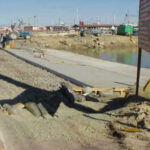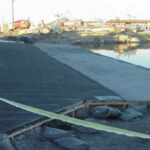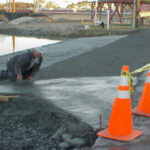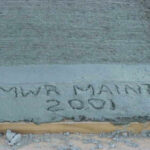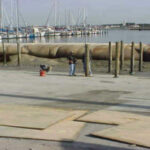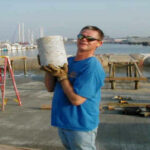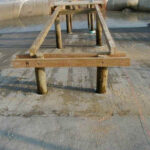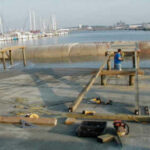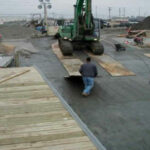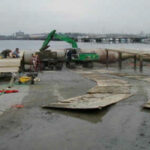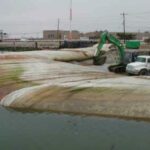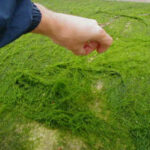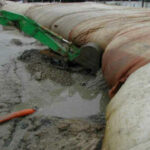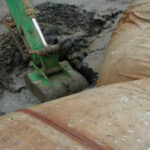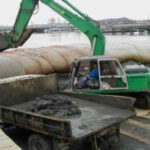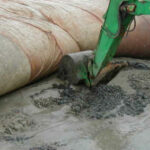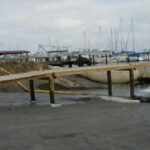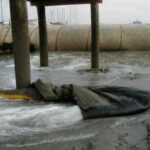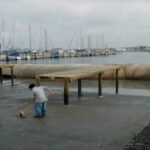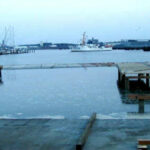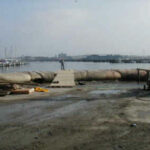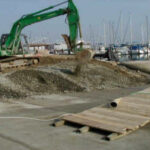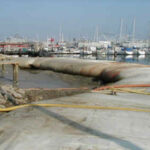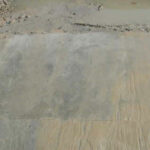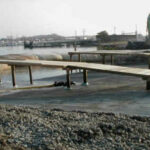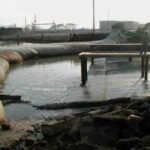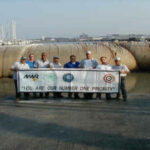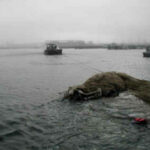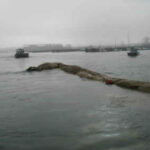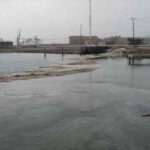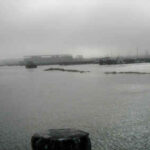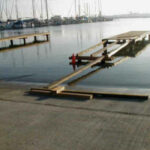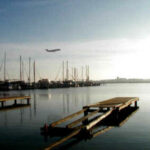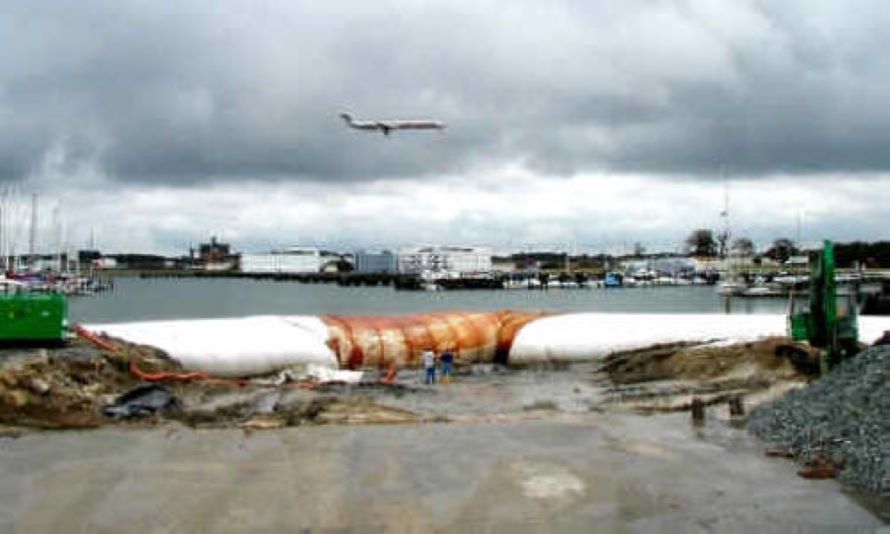
Project overview: A 16' high AquaDam® was needed to control 10 ½' of water at high tide. Removal of the old boat ramp was completed after the site was coffer dammed with steel sheet-pile, which failed before the new boat ramp could be poured. Further sheet-piling was prohibitively expensive, so the U.S. Navy called AquaDam®.
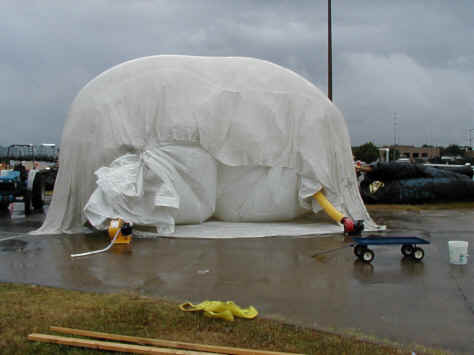
This picture shows the end of the open-ended AquaDam®. It is being inflated with air using two 8" blowers. You can clearly see the two white inside tubes surrounded by the white outside tube.
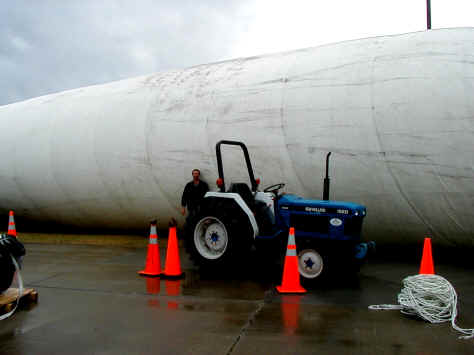
The AquaDam®'s height (when inflated with air) was approximately 20'. The outside tube has a circumference of 80' when inflated.
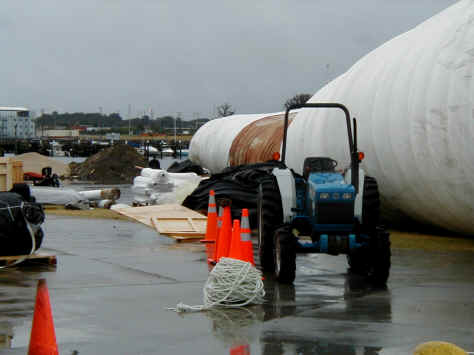
This unit was 350' long. In the middle is a red 96' long "band" for reinforcement.
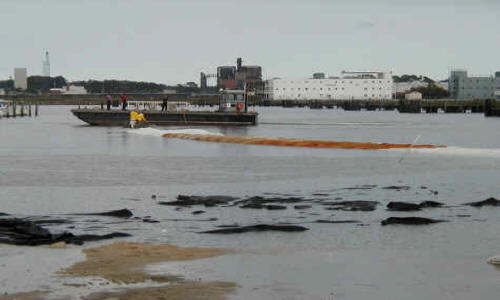
The AquaDam® has been deflated and is now being pulled out into the harbor by a small Navy barge.
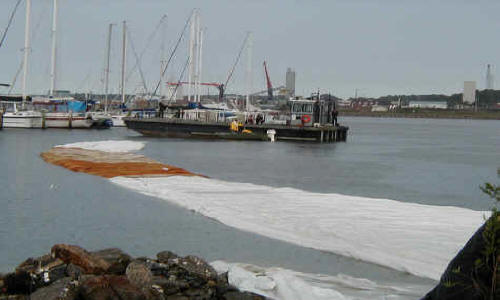
At this point, the AquaDam® floats on top of the water, but it will sink if not put into place in a timely fashion, due to the weight of the materials incorporated into an AquaDam® of this size.
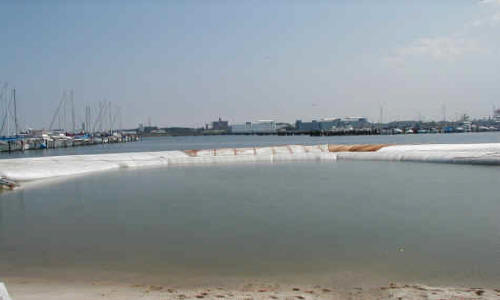
The large AquaDam® has been installed and inflated in a crescent shape, with an over inflated 8' high AquaDam® in front of it to give it support. At this point, the water inside is trapped, and does not fluctuate up and down with the tide.
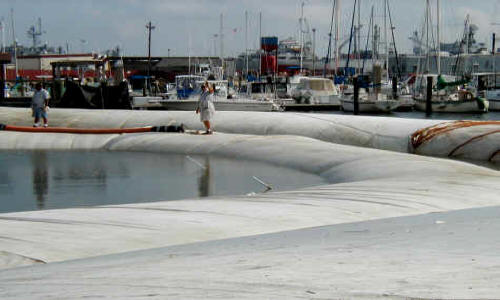
The smaller AquaDam® was installed first, and the larger unit was then placed along the outside edge. The 1" poles in the middle of the picture represent the edge of the work area. The AquaDams® had to be placed around these markers. It is much easier to place a smaller unit in the exact spot needed and use it like a form for the larger AquaDam®'s placement.
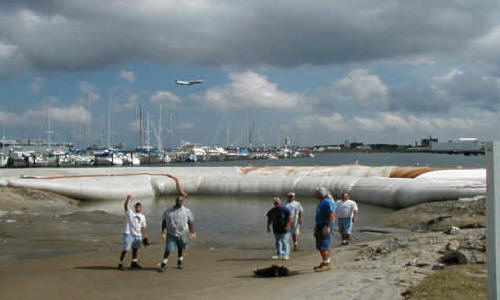
Our first attempt at dewatering the work area. Everything looks great, but there's trouble in the making. Notice the starting end (left side) of the smaller AquaDam®.
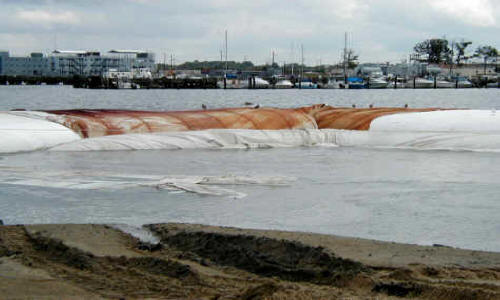
The massive pressure of the larger AquaDam® leaning against it became too much for the open end of the 8' high AquaDam®. The pressure forced it off of the bank, allowing the water inside to run out. The smaller AquaDam® deflated and was later removed.
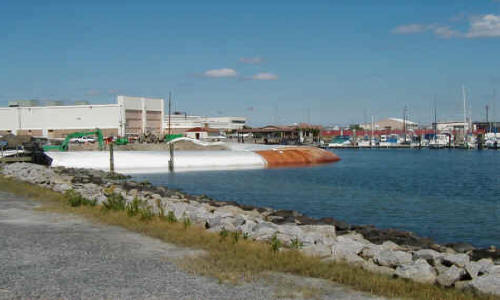
A view of the outside of the cofferdam during medium tide. Difference between high and low tide was 3-4'. The deepest water was 11½' deep at high tide (next to the red part of the AquaDam®). The average water depth was 10'.
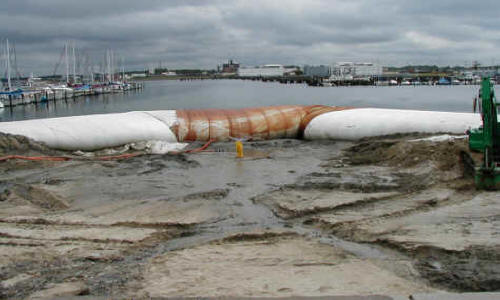
The work area has been dewatered even without the 8' high AquaDam® for support.
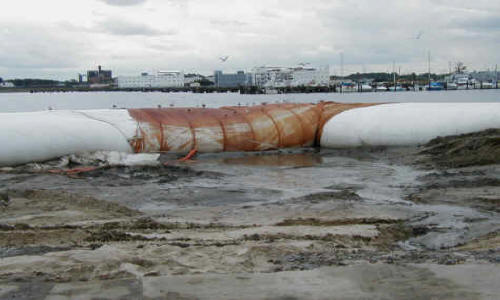
Another view of the dewatered work area.
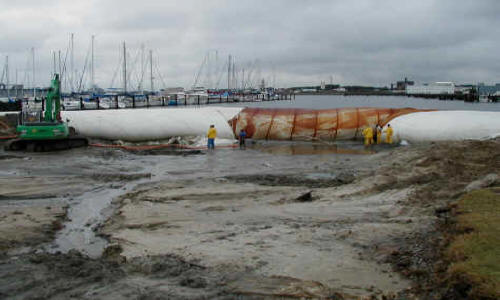
The excavator is placing fill material (dug out of the bay bottom) next to the AquaDam® to help support it. The outside edge of the AquaDam® is actually 1-2' lower than the area where the workmen are standing.
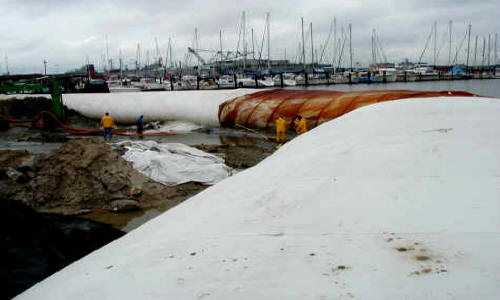
The workers next to the red part of the AquaDam® are standing on a 2' high berm left over from the sheet pile cofferdam.
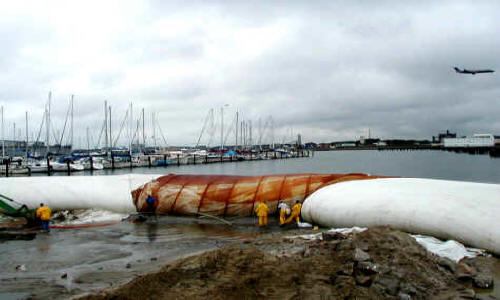
The workers are digging a sump hole so that the 6" suction hose will work properly.
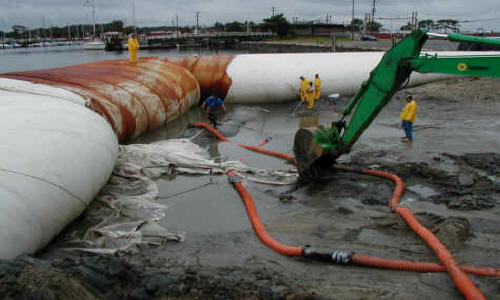
The two 6" suction hoses were used to bring the water level down quickly. Seepage was so minimal that one pump running on idle was all that was need to keep the work area dewatered.
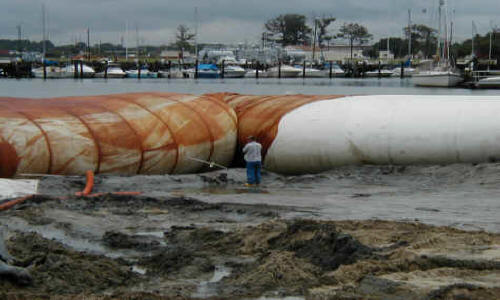
This worker is looking at the pole the AquaDam® had to go around. All of the mud had to be removed before gravel could be laid to form the foundation of the new boat ramp.
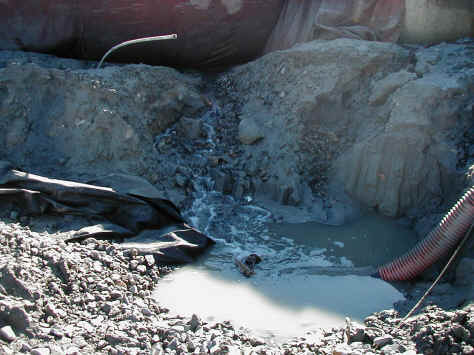
This is the entire amount of seepage coming underneath the AquaDam®. This is very, very little. The sediment on the bottom of the Chesapeake Bay forms an ideal seal.
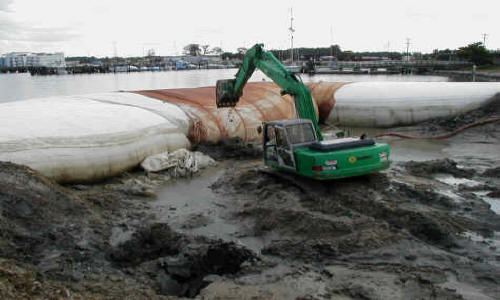
One of the first things undertaken after installing the AquaDam® was to use local fill material that had been removed to back up the AquaDam® until the last part of the project. That mud looks kind of deep...
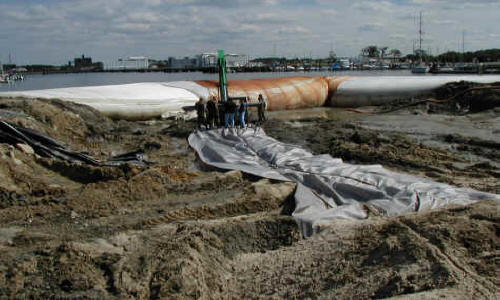
To no great surprise, yes, it is mud, and yes, this piece of equipment will sink in it. Even the best ideas sometimes have drawbacks. The gray material was used so people could walk out on top of the mud to hook the excavator up to a chain.
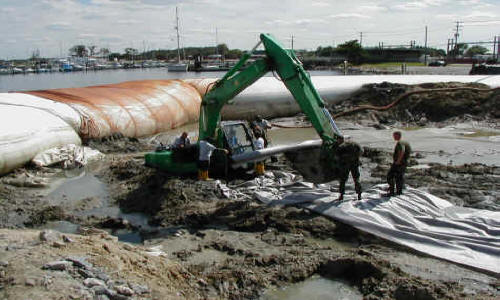
This is one very stuck piece of equipment. It is now buried so deep in the muck that the operator could barely turn the cab from side to side.
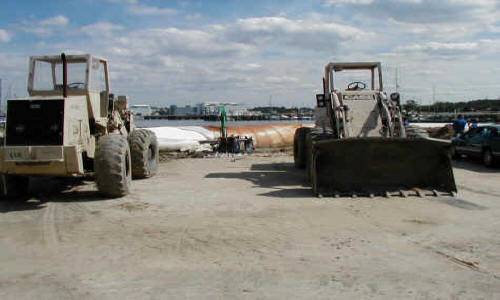
The first attempt to free the excavator was with these two pieces of equipment pulling on a chain. They were not successful. Actually, it didn't even budge. Several hundred thousand dollars are now at risk. Equipment was only supposed to work during low tide, and high tide is fast approaching.
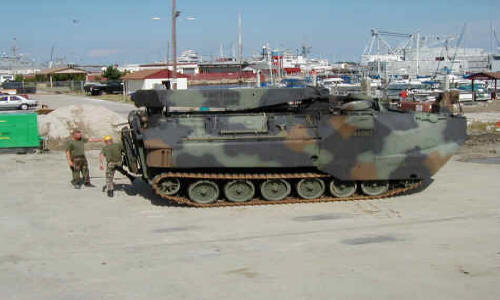
What happens when the Marines get stuck? They call this unit in to pull them out. This is an APC customized with winches and cables to pull even the largest Marine vehicles out of the mud. They were just across the street, and a case of Budweiser convinced them to help us in a timely fashion.
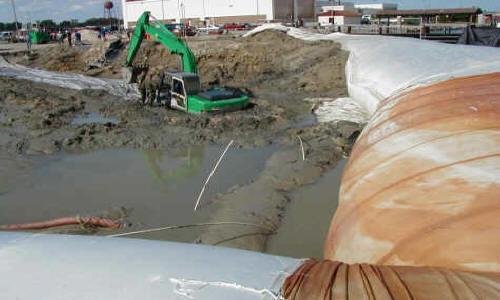
The Marines and the operator are discussing how to free the trapped excavator, which is slowly sinking deeper and deeper into the mud. Notice the three white stakes that mark the end of the boat ramp.
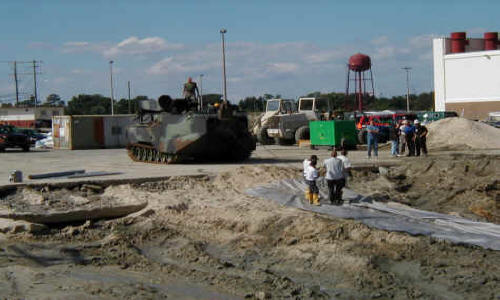
Pulling a very heavy cable and block to be attached to the excavator. To keep the workers from sinking knee-deep in the mud, a strip of filter fabric was put down.
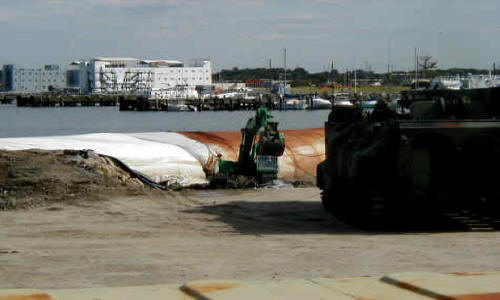
Here she comes! Marines to the rescue.
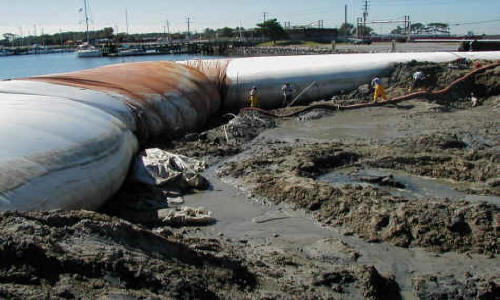
All of this soupy mud still has to be removed. You can clearly see where the excavator was trapped.
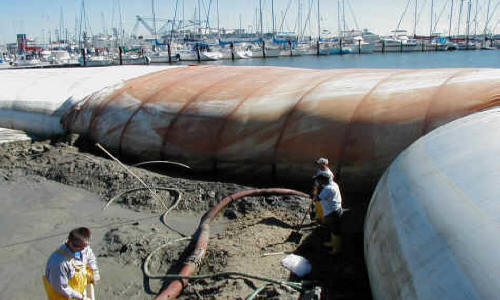
The AquaDam® and the water of the Atlantic Ocean tower over the workers.
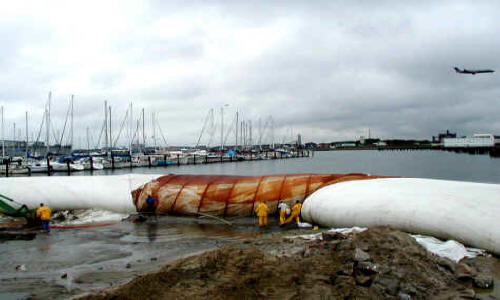
The sailboats are owned by retired Navy personnel. Using an AquaDam®, very little noise was created. Sheet piling was very noisy (BANG BANG BANG) and expensive. Reportedly, the sheet piling "twisted like pretzels" under the tremendous water pressure.
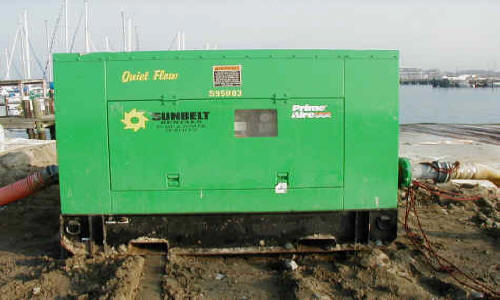
Since some of the owners live on their boats, special super-quiet insulated pumps were used to keep noise levels to a minimum.
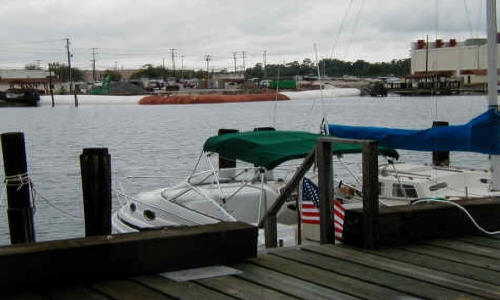
A view from across the bay during high tide.

Viewed from the opposite side, the size of the AquaDam® is apparent, compared to the two men standing in front of it. The outside of the AquaDam® is 2' lower in elevation than where the men are standing.
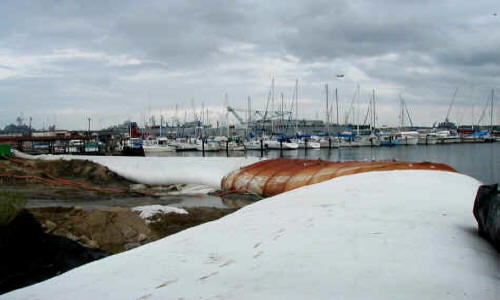
The width of the AquaDam® has to be taken into consideration. This dam has a circumference of 80' and is 350' long.
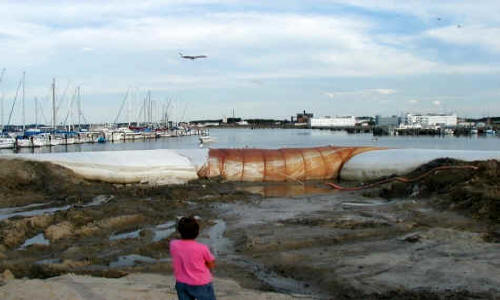
The project site is located directly in the path of the Norfolk International Airport runway. Notice the size of the boat behind the AquaDam®. It looks very small, but it is actually over 20' long. Also, notice all of the muck that has to be removed.
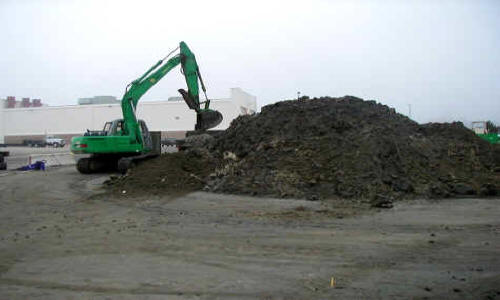
Here, an excavator is loading a dump truck. A huge amount of muck had to be removed before construction could be started on the boat ramp. This pile represents only about 1/3 of it.
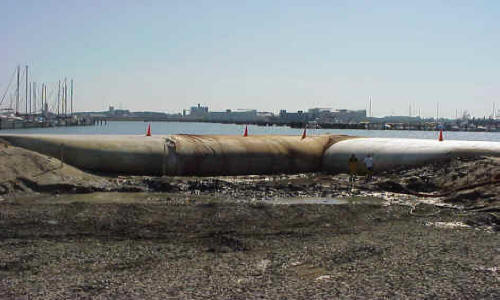
Overview of the dewatered project area before muck removal was completed. Notice the two men on the right hand side. Street cones with flashers were placed on top to warn boaters at night.
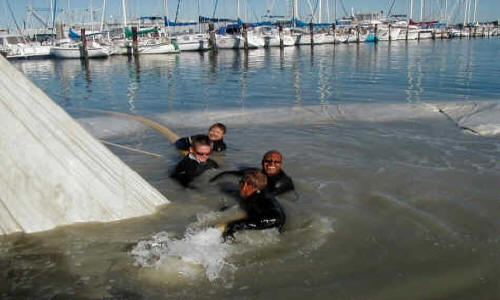
Because of unpredicted high tides caused by a combination of a low pressure front and a full moon, a complete failure of the AquaDam® has resulted. Plan two has been implemented. This required reducing the radius of the cofferdam by shortening it from 350' to 250' long. When it failed, the sand that was piled up next to it fell on top. Step #1: removal of the sand that was backing up the corner of the AquaDam® with a 6" hose.
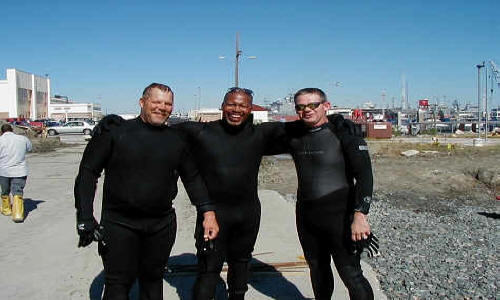
It took at least 3 members of the MWR work crew to man the 6" hose used to wash the sand off. From left to right: Aqua-Vern, Aqua-Keith, and Aqua-Dave. The job could not have been done without their good-natured support. Wetsuits provided by MWR.
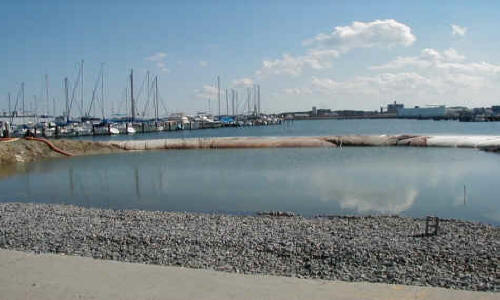
The AquaDam® has been shortened by 100', reducing the proposed boat ramp slab by 10' in length. The AquaDam® is now severely damaged and cannot withstand the pressure of dewatering during high tide (10-11' of water depth at it's new location). Low tide water depth is 7' or less. Dewatering can only take place during low tides.
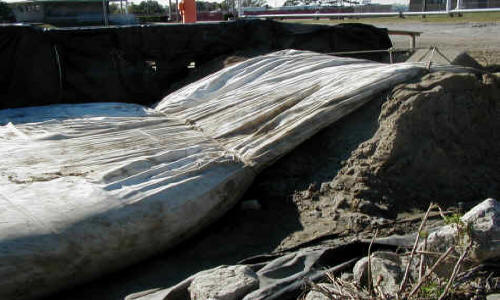
The end of the AquaDam® is bunched up and secured with a rope next to the artificial fill berm used to start it. It was about 35' further back during the first installation and has now been moved to shorten up the length. Water levels inside the AquaDam® were at the top of the mound of dirt +1-2'.
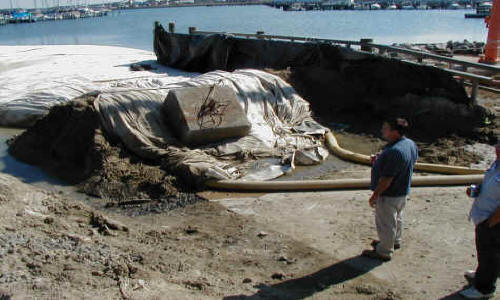
This shows the material on the back side of the berm. Because the AquaDam® is buoyant and has a tendency to move at high tide (with water on both sides), this problem was overcome by placing this 5,000 lb. cement block on the end.

Water inside the work area has to be maintained using pumps. This is a very big job, considering that you have to worry about two high and low tides a day, making sure that the water heights on both sides of the cofferdam stay the same.
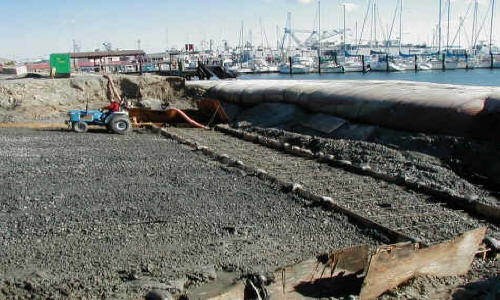
The muck has been removed. Geotextile fabric has been laid down, and crushed shot rock has been placed over the top. The forms and rebar for the first 12' concrete pour are now ready. Work is only permitted during low tide. Plywood helps to keep muck from inundating the work area.
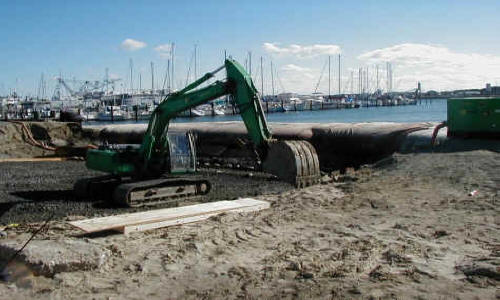
Finishing touch-ups to the sides of the work area.
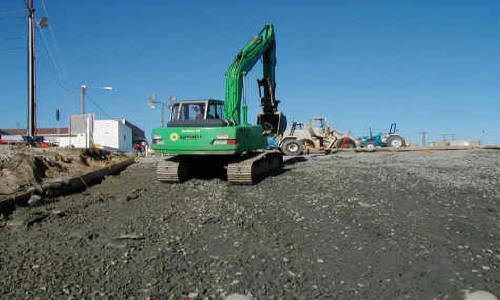
This gives a better perspective on the slope of the 110' long boat ramp. A lot of work has gone into it to get it to this point.
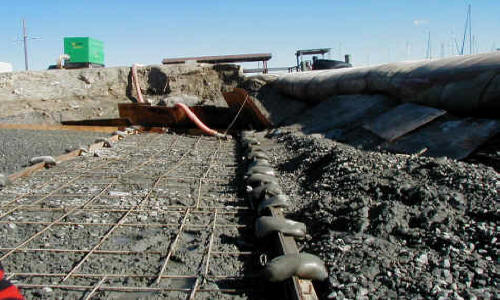
A close up view of the forms and rebar closest to the AquaDam®. This area was dewatered several times before the cement truck arrived for the first pour.
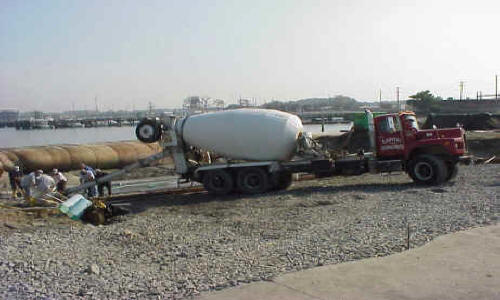
Concrete pour on the second section of the boat ramp. The mucky area now supports the weight of a fully loaded concrete truck. This demonstrates the superb job done by the MWR crew for the construction of the foundation of the boat ramp.
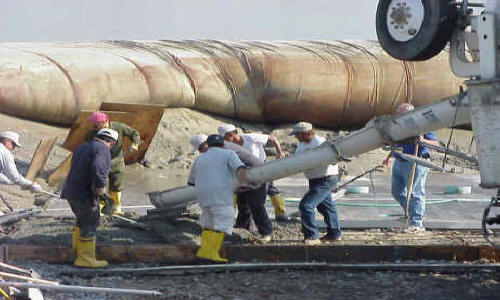
This is concrete pour #3. The crew is working their way up the boat ramp, 12' at a time.
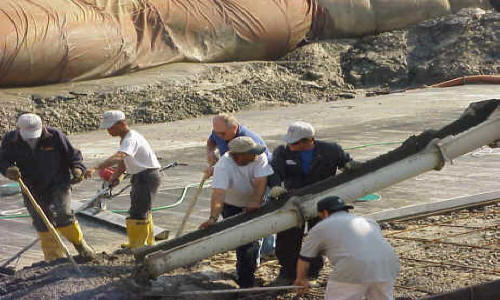
A close up view of the third pour. Keep in mind that to get to this point, only 4 hours of work can be accomplished per day. The rest of the time,this area is under water.
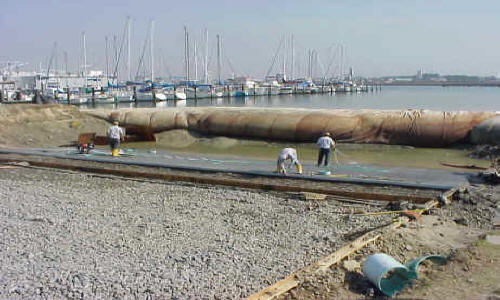
Cleaning off the first 3 pours. The area is now ready for pour #4, which will have to be done the following day during low tide. Until then, the work area will be filled with water to relieve pressure on the damaged AquaDam®.
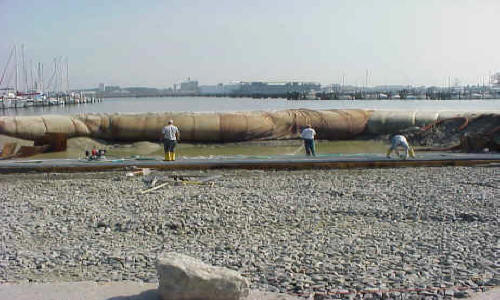
An overview.
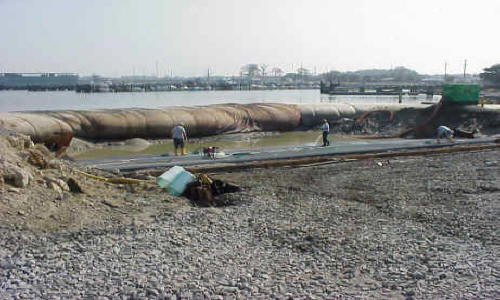
Another overview.
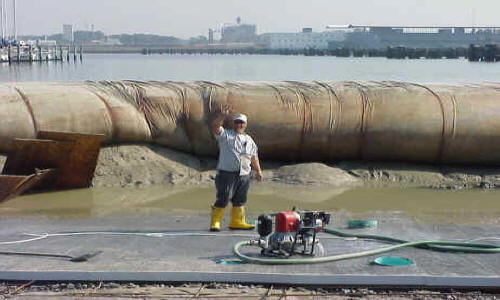
Another overview.
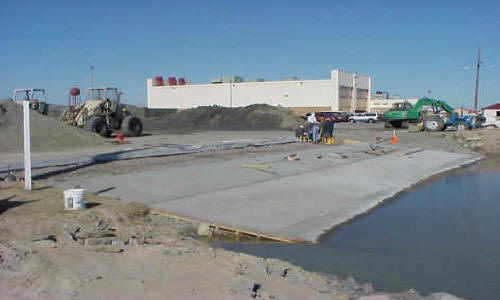
The work area has been filled with water during high tide to relieve pressure on the damaged AquaDam®.
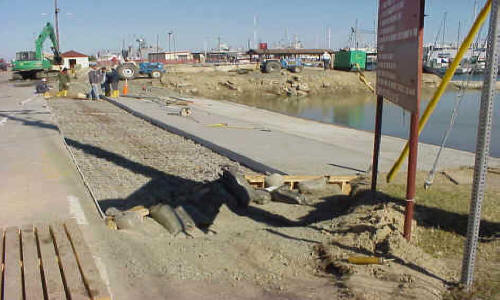
Only the last concrete pour remains to be done. It is above the ordinary high water mark.
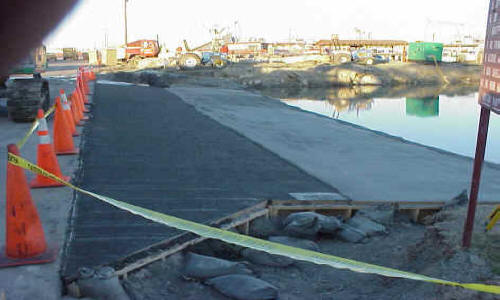
The last pour has been completed.
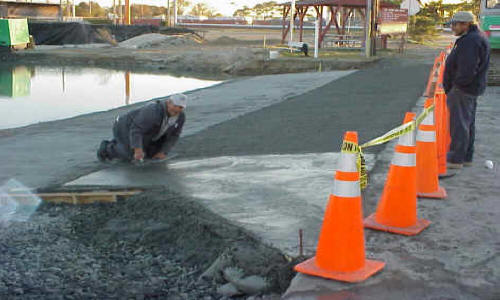
Smoothing out the last edge.
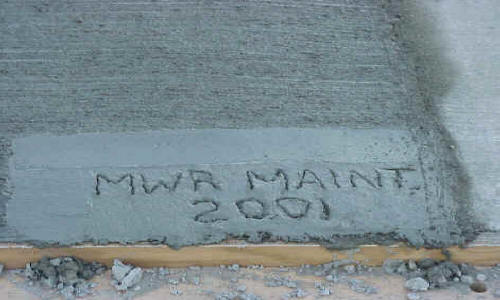
The finishing touch - taking credit for a boat ramp concrete pour job well done.
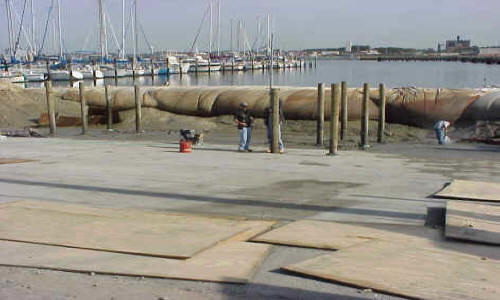
Walkway poles have been inserted through the concrete. Each one has a piece of PVC pipe around the base so that the concrete does not actually touch the pole. When ice forms the poles will be able to expand without cracking the concrete. The PVC pipe was installed during the concrete pours.
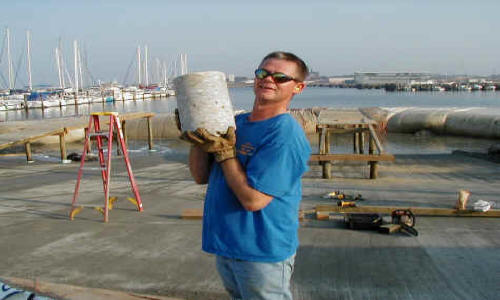
For the poles above the ordinary high water mark, PVC pipes around the base were not necessary. A coring tool was used to cut out a circular chunk of concrete and the pole was dropped into the hole.
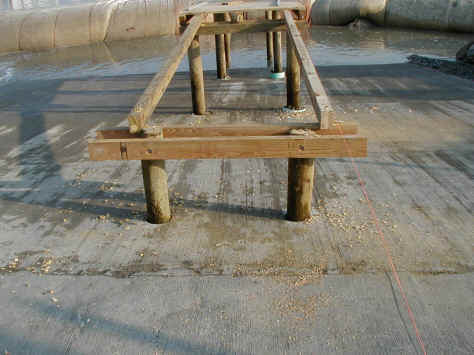
A closer view of the second section of the walkway.
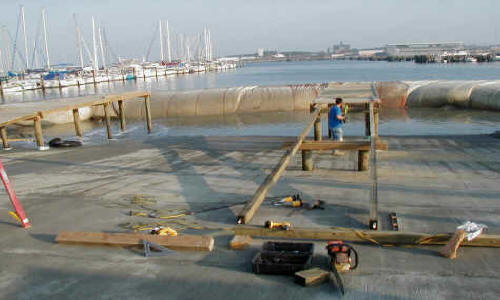
Starting the third section of the walkway.
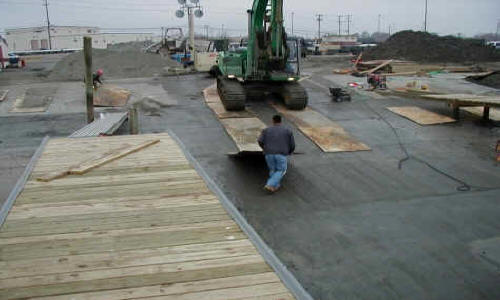
Even though the concrete has already been poured, muck still has to be removed from the toe of the new boat ramp. Boards were put in place to prevent the excavator's treads from damaging the newly laid concrete.
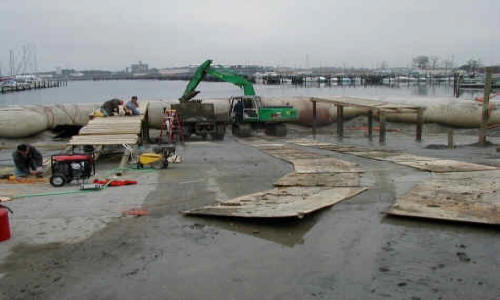
A view from the top of the boat ramp.
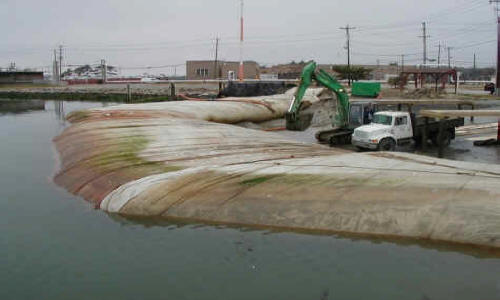
Notice the algae on the outside of the AquaDam®.
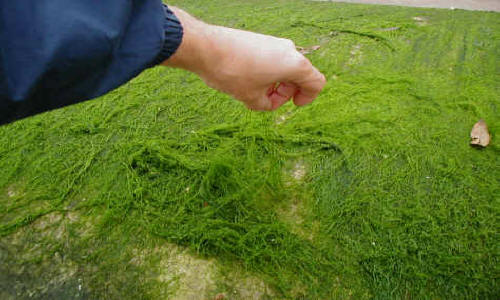
On the other side, the algae was even thicker, and grew to extraordinary lengths in a manner of 3 months.
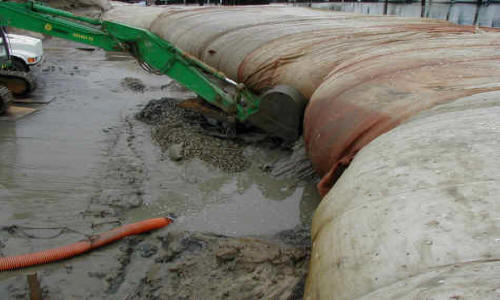
This picture shows how close to an AquaDam® you can dig if you are careful.
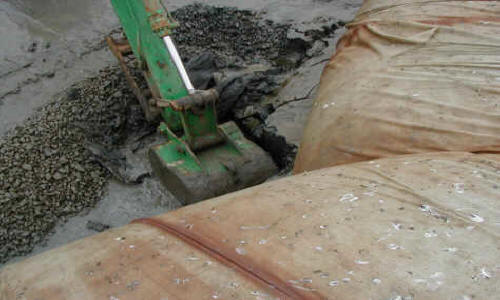
View from the top.
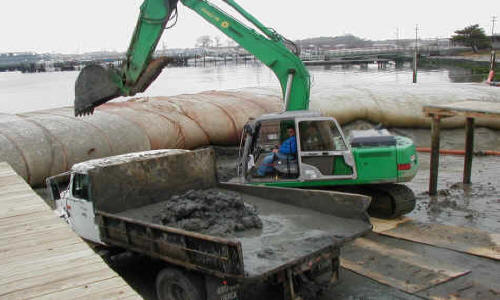
All of the muck had to be loaded onto a dump truck for removal.
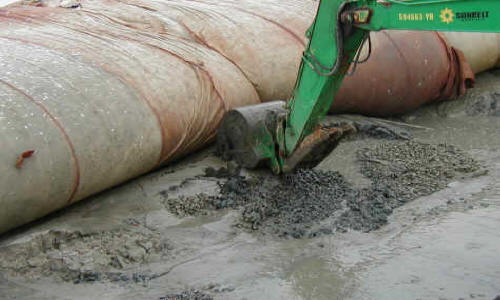
Notice the small amount of leakage under the AquaDam®.
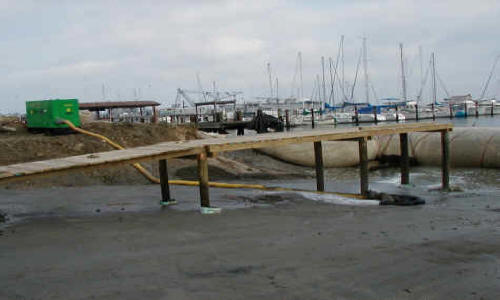
One of the walkways has been completed. The work area is being filled with water as high tide approaches. Notice the end of the hose.
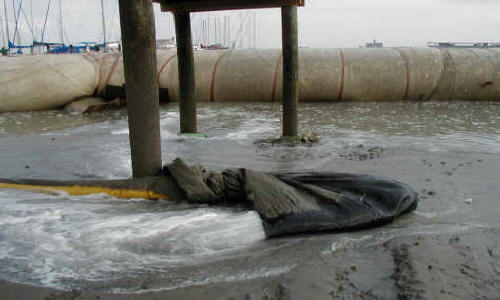
The hose end has a piece of material tied over it to dissipate the flow of water.
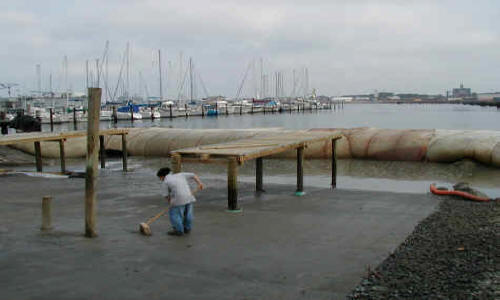
Giving the ramp one last cleaning.
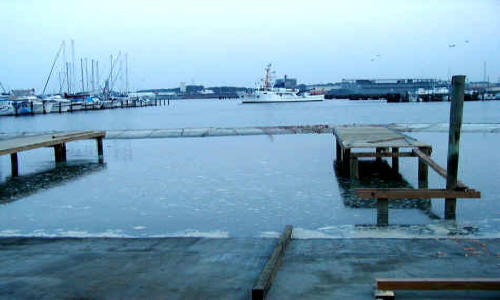
A view of the walkways during high tide.
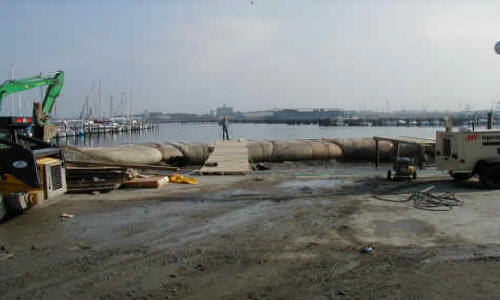
Dewatering for the last time.
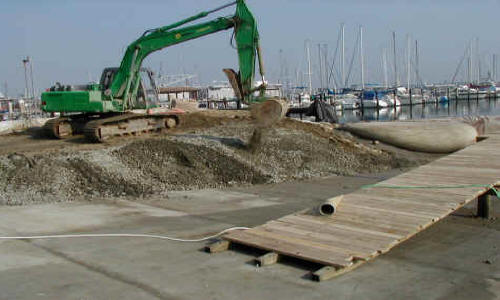
Shot rock is being placed along the edges of the bank to prevent erosion.
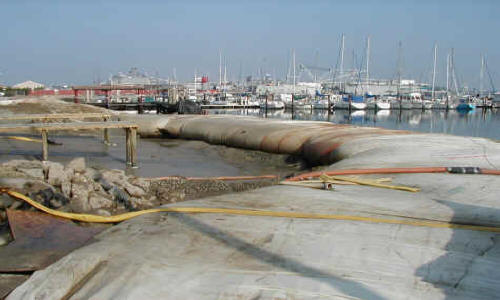
Overview of the finished product.
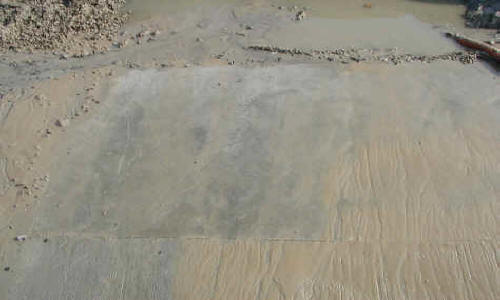
Cleaning off the concrete.
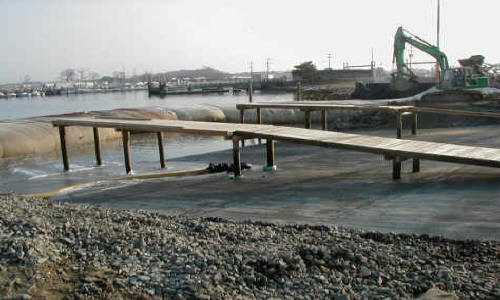
Adding water for the last time.
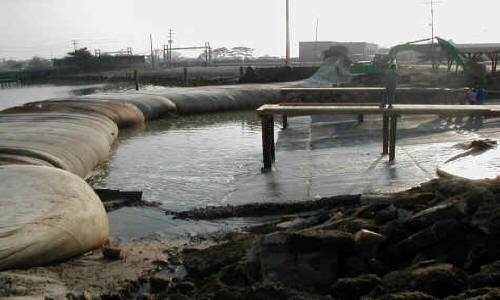
Final overview.
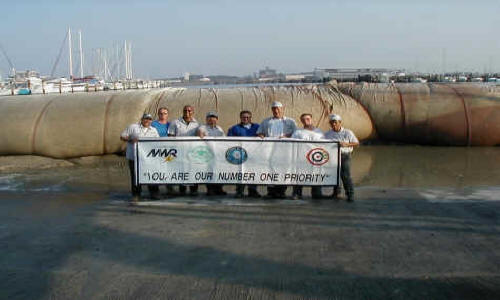
The MWR crew: Skeeter, Dave, Keith, Carlos, Allen Ritz (the boss), Vern, Bill & Ernie. A great crew to work with. They had their doubts in the beginning, but they sure have faith in us now!
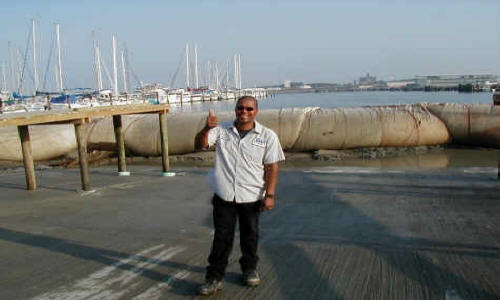
A thumbs-up from Aqua-Keith. Now it's time to remove the AquaDam®.
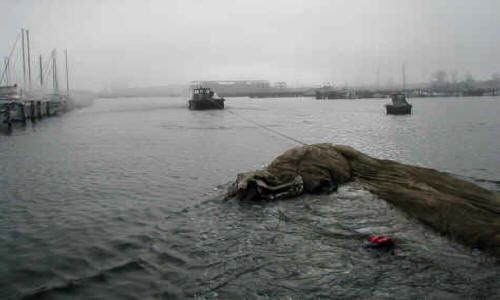
The end of the AquaDam® has been pulled off the bank after half of the water was pumped out. The other half of the water inside the AquaDam® is removed by the open- ended sleeves being pulled off the water molecules to empty the AquaDam®.
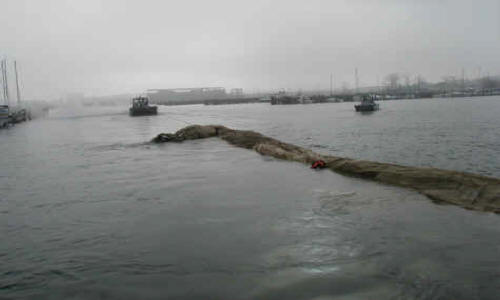
The Navy barge had to be used to pull the AquaDam® in a straight line so that the other end could be pulled up the new boat ramp. It will be rolled up for later use.
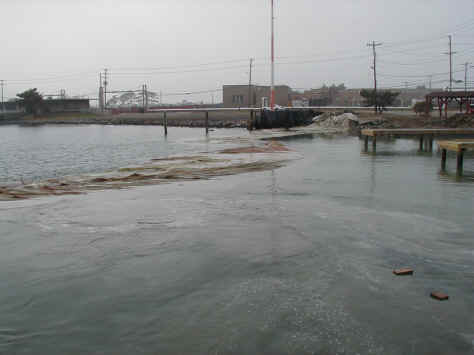
The AquaDam® is being pulled from its place on the bank.

350' is one long AquaDam®.
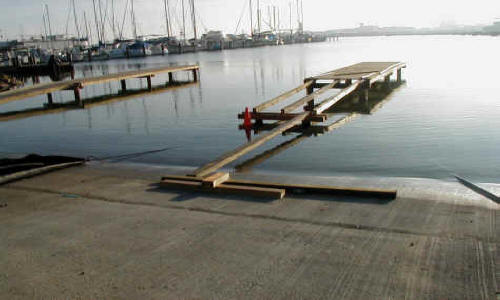
High tide.
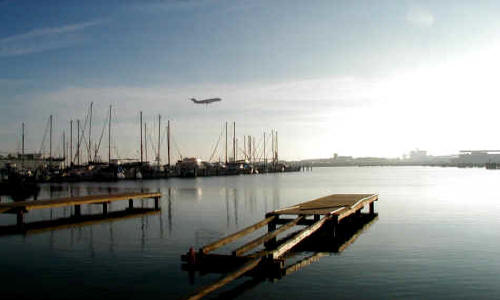
Final overview.
